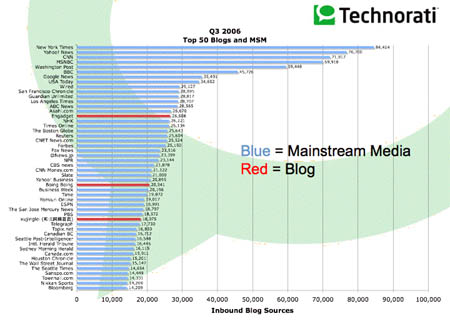 |
TV News in a Postmodern World
Links: The Currency of the Machine June 2007
|
 |
|
Yet countless eons of mythology, religion and science have brought us no closer to unlocking the mystery, and the best we can do as the human race is to say, "To each his own." It is with a degree of similar awe that we stand today considering the Machine that Kevin Kelly described in his seminal 2005 essay, We Are The Web, a futuristic glimpse into what it is we're all building together with this thing called the World Wide Web. Dwarfing all efforts to create the ultimate science fiction "supercomputer," the web is a living and growing mass of artificial intelligence, and we are amazed and just a little bit scared.
In 10 years, the system will contain hundreds of millions of miles of fiber-optic neurons linking the billions of ant-smart chips embedded into manufactured products, buried in environmental sensors, staring out from satellite cameras, guiding cars, and saturating our world with enough complexity to begin to learn. We will live inside this thing. Kelly went on to give the Machine a kind of Tower of Babel twist, because we're all building this thing together. We are the Machine. We are the web.
When we post and then tag pictures on the community photo album Flickr, we are teaching the Machine to give names to images. The thickening links between caption and picture form a neural net that can learn. Think of the 100 billion times per day humans click on a Web page as a way of teaching the Machine what we think is important. Each time we forge a link between words, we teach it an idea. The word "link" is at the heart of all that is the web, and it is vastly more important than any of us realizes. The idea of links and linking is Web 101, and it's overlooked in its significance by traditional media companies, whose best and brightest generally think of links as only a way to move people around our sites or connect our content to interested parties. But links and linking are the real currency of the web — with a value greater than cash — and one that might some day actually become a form of cash in a web-based economy. There already is a dollar value placed on links, and it's found in the seedy underbelly of the Search Engine Optimization world. While the majority of industry practices are aboveboard, many companies clog the comment sections of blogs with false entries that create links for clients. Since search engine algorithms view links as a validation of influence, this actually raises the unscrupulous companies' clients in search engine rankings. These same companies create sites known as "link farms" and build phoney blogs known as "splogs" in order to drive client rankings up the search engine chain through links. While the search engines are aware of this and take measures to block these kinds of tactics, it is still a thriving business. That's real dollars attached to links. Digg, the popular social-bookmarking site, is built entirely on links to stories that the users vote on to determine ranking in the community. Here not only do the links have value, they function as the content of the site and are manipulated by core users in an endless popularity contest to see who can control the home page. Links have tremendous value here, because a single home-page link can mean thousands of unique visitors in a very short time. Another popular social-bookmarking site, Del.icio.us is a place where people store — you guessed it — links. Links have value. They are the currency of the web, and as the Machine gets smarter and is able to qualify and validate links, their value will increase. Like any other currency, they will be traded for goods and services. If you link to me, I should pay you for that, because it has real value to me. As media companies, we should think carefully about this. A permanent link — or as least as permanent as the web permits — has the highest value, for it keeps on giving. Technorati, the blog search engine, uses permanent links, in part, to measure authority — a website's ranking against others. Remember that links are considered a measure of influence, and this is an important metric in the Media 2.0 space.
The only way to move up in ranking (if that's what's desired) is to write more posts, comment on other blogs, and generally behave like a grown-up. The Golden Rule is at work here, too, because the best way to get links is to give them. And all the while we're doing this, we're teaching Kevin Kelly's "Machine" to think. Links from blogs are probably the most important reason for mainstream media companies to stay clear of pay walls in making their work available to the rest of the world. The Wall St. Journal, for example, is happy with the money from its corporate-paid subscription model, but the truth is the paper's stock as an influential voice in the culture can only go down. The Journal recognizes this and selects certain items that it offers to bloggers free daily in hopes of their links, but this is viewed by many as condescending and manipulative. Technorati founder Dave Sifry regularly publishes data showing the most linked-to websites. The image below (click to enlarge) shows The New York Times is the top recipient of links and therefore the most influential information website in the world. The blue lines represent media companies (including Google and Yahoo); the red lines represent blogs. This will all be monetized one day. The Machine will make it easy.
 Click to enlarge Two years ago, when Sifry first published this graph, The Times was on top with 33,000 inbound sources. In just 18 months, that had expanded to what's shown above, 84,414. This is an indication of not only growth in the online information space but also of the value of those links to The Times and its advertisers. That the paper puts its archives behind a pay wall kills many of those links, however, and sooner or later, they'll have to address the issue. The Machine has a long memory. Another thing that's changed dramatically about this graph in two years is that the top 50 is almost entirely mainstream sources, whereas blogs made up about half in 2005. This is likely evidence of the awakening by these news organizations that's taken place since then, along with advances in the application of RSS and the distributed media culture. The professional news industry is, of course, quite content to sit back and let others link to it. It's a traffic strategy. This despite the fact that many in the business criticize the linkers as parasites who build reputations and audience by linking to their work. This is an absurd and dangerous perspective, because there are millions more red lines in the long tail of the above chart than the blue lines that sit at the top. The mainstream press views outbound linking as irrelevant — or worse, suicidal. The idea is to assemble crowds in one place rather than disperse them to the winds. Besides, the mere thought of actually linking to another person or organization is anathema to the concept of original reporting or scarcity of content, and the whole traditional press suffers as a result. It suffers, because the news is bigger than that which any limited, single organization can get its arms around. It suffers, because its unwillingness to participate in the conversation that is news leaves it isolated, naive and mere pawns of the status quo. It suffers, because without participation, the press will never discover the wonder or the tools of the Personal Media Revolution. And it suffers, because in the end, the Machine will calculate its value downward in the overall scheme of importance. And given how search algorhitms work, an outbound link from The New York Times would carry more weight than, say, The Seattle Times and thus be worth more web currency. Things are very different in the blogosphere, however, where bloggers lift each other by participating in each other's conversations and THE conversation that is "news" via the Machine. If the traditional press could bring itself to function as the life of the party — the guy who brings the best stories, shares them with party-goers, and takes the time to listen to everybody else's stories — it could function in a valid role as "conversation starter" with all the benefits of the above. That's because all of the tools that the blogosphere uses to form a gigantic handshake for the flow of information are there to serve the conversation, not the one-directional necessity of the mass-marketing business model. It's easy for us to see why we want everybody linking to us — and we should do whatever we can to make that as easy as possible — but the conversation will be served, because, as Kevin Kelly so brilliantly put it, "we" are the Machine. The World Wide Web is a postmodern marvel of collaborative participation, and humankind stands once again at the shore of its own existence, a link away from everything.
From this embryonic neural net was born a collaborative interface for our civilization, a sensing, cognitive device with power that exceeded any previous invention. The Machine provided a new way of thinking (perfect search, total recall) and a new mind for an old species. It was the Beginning. Links are the new currency. We should buy and sell wisely. © Terry Heaton
|
|
|
Write a Letter to the Editor
Join our Mailing List
© The Digital Journalist
|
 Long ago on some distant shore, our ancestors looked up at the night sky and felt two contrasting emotions. The awe and majesty of the heavens awakened a sense of insignificance and aloneness, the kind that comes when confronted with the magnitude of life itself. As these same eyes were opened to a powerful sense of oneness with all that majesty, the human quest for meaning was birthed.
Long ago on some distant shore, our ancestors looked up at the night sky and felt two contrasting emotions. The awe and majesty of the heavens awakened a sense of insignificance and aloneness, the kind that comes when confronted with the magnitude of life itself. As these same eyes were opened to a powerful sense of oneness with all that majesty, the human quest for meaning was birthed.